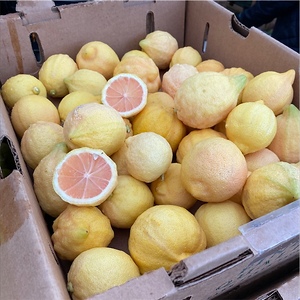


Pink Lemons
Estimated Inventory, lb : 0
Description/Taste
Pink lemons are small to medium fruits that have an oblong to oval, slightly tapered shape. The rind is thin, semi-rough, and covered in vertical, variegated green and white striping. Each green stripe is ridged, creating a textured surface, and as the fruits mature, they develop prominent oil glands while the striping fades. Underneath the surface, the flesh is blushed with a light pink, rosy hue and is tender, juicy, and succulent, being found seedless or containing a few seeds. When squeezed, the fruits will emit a clear juice despite the flesh being colored. Pink lemons are aromatic, bearing a bright, citrus scent, and contain low acidity, creating a sweet, tangy, subtly tart, floral, and fruity flavor. Pink lemon trees also showcase variegated and glossy green and white ovate leaves and fragrant flowers, known among citrus enthusiasts as one of the most aromatic varieties.
Seasons/Availability
Pink lemons are most often harvested in the summer, but the fruits can also ripen in the late fall and early spring, depending upon growing conditions.
Current Facts
Pink lemons, botanically classified as Citrus limon, are a specialty citrus belonging to the Rutaceae family. The variegated lemons grow on an evergreen tree reaching up to four meters in height and are highly valued as an ornamental landscape cultivar for the tree’s speckled green and white leaves. Pink lemons were discovered as a natural mutation growing on a eureka lemon tree in the early 20th century in Southern California. The fruits have been cultivated for over 90 years and were eventually selected for commercial cultivation, favored for their unique peel striping, blush-colored flesh, and less acidic, tangy flavor profile. Pink lemons are also known as Variegated Pink lemons, Pink Lemonade lemons, Pink-Fleshed Eureka lemon, Zebra lemons, and Variegated Eureka lemon. In the modern-day, Pink lemons are a less productive variety compared to the common eureka lemon, limiting their availability, and are seasonally found through local markets and specialty stores in warm climates, specifically Southern California. The striped fruits also recently increased in popularity due to exposure through social media, highlighting the unusual appearance of the flesh and peel through photo-based posts.
Nutritional Value
Pink lemons are a good source of vitamin C to strengthen the immune system, reduce inflammation, and boost collagen production in the skin. The lemons also contain fiber to regulate the digestive tract, calcium to protect bones and teeth, and provide lower amounts of lycopene, a compound that gives the flesh its pink hue and contributes antioxidant-like properties.
Applications
Pink lemons have a sweet, tangy flavor well suited for flavoring culinary dishes, baked goods, and beverages. The lemons can be used in any recipe calling for common lemons and can be sliced and squeezed for their juice, adding bright flavors to seafood dishes, vegetables, curries, soups, and grain bowls. The juice is also frequently mixed into salad dressings, vinaigrettes, and sauces. In addition to savory dishes, Pink lemons are used for their juice and zest to flavor desserts and baked goods, including pies, cakes, scones, lemon bars, and tarts. The lemon’s juice can be frozen into popsicles, or slices can be candied as an edible garnish. Beyond flavoring culinary preparations, Pink lemons can be sliced and stirred into water, lemonade, and cocktails, sweetened with sugar, honey, or agave for a balanced taste. They can also add mild acidity into mixed drinks and sparkling beverages. It is important to note that the lemon’s juice will be clear and does not contain a pink hue. Pink lemons pair well with herbs such as lavender, rosemary, thyme, and marjoram, meats including poultry, turkey, pork, and fish, other seafood, honey, and fruits such as blueberries, strawberries, coconut, and peaches. Whole, unwashed Pink lemons will keep up to one month when stored in a plastic bag in the refrigerator.
Ethnic/Cultural Info
Pink lemons are sometimes labeled as Pink Lemonade lemons in commercial markets, but despite the fruit’s pink-hued moniker, the liquid extracted from the flesh is clear. The pink descriptor refers to the lemon’s flesh coloring, and the boutique citrus variety is popularly sliced and mixed into pink lemonade beverages as a festive ingredient. Pink lemonade was created over 100 years before Pink lemons were discovered and have been a favored beverage since the late 1800s. The drink’s origin can be traced back to the circus, and there are two main legends associated with the creation of the drink. The first story recalls a circus vendor selling lemonade. The vendor ran out of water for his lemons, and according to the story, he used water from a basin that had just been used to wash the red tights of a circus performer, dying the lemonade pink. The circus vendor sold the oddly colored lemonade as “strawberry lemonade” and ended up selling more drinks than usual due to the beverage’s unique coloring. The second origin theory is connected to Henry E. Allott, a circus performer who accidentally dropped cinnamon candies into lemonade, turning the beverage pink. Regardless of the two origin stories, pink lemonade quickly became a favored American beverage. In the present day, Pink lemons are a favored garnish to add visual appeal to the drink.
Geography/History
Pink lemons were discovered growing as a spontaneous mutation in 1931 on a eureka lemon tree in Burbank, California. The lemons were selected for their variegated coloring and were commercially propagated with the help of A.D. Shamel as a specialty variety throughout Southern California. Pink lemons share similar growth characteristics to eureka lemons, but the trees are slightly less productive, contributing to the fruit’s rarity. Today Pink lemons are a favored home garden variety and are cultivated on a limited scale through select growers for purchase through farmer’s markets and specialty grocers. The lemons thrive in warm climates and are primarily found in California, Arizona, Florida, and Texas.
Recipe Ideas
Recipes that include Pink Lemons. One

















